Andrew Collins's Blog, page 31
September 28, 2012
Nicellissima
 It’s all sex and drugs and buns this week on Telly Addict (three things apart from telly, of course, that you can be addicted to). Nigella returns to BBC2 in the Italian-themed Nigellissima; Keith Allen returns to C4 with Drugs Live, except he doesn’t really, he’s just one of 25 volunteers taking drugs, but not live, in actual current affairs’ latest attempt to outdo Brass Eye; and over at the Great British Bake Off, two bakers will stop rising in a double-knockout. But which two? And will either of my two favourites remain? (There are no Bake Off spoilers here, by the way, so if you have “taped” Week 7, you may tune in with confidence. Having said that, it’s bloody Friday! Watch the programme!)
It’s all sex and drugs and buns this week on Telly Addict (three things apart from telly, of course, that you can be addicted to). Nigella returns to BBC2 in the Italian-themed Nigellissima; Keith Allen returns to C4 with Drugs Live, except he doesn’t really, he’s just one of 25 volunteers taking drugs, but not live, in actual current affairs’ latest attempt to outdo Brass Eye; and over at the Great British Bake Off, two bakers will stop rising in a double-knockout. But which two? And will either of my two favourites remain? (There are no Bake Off spoilers here, by the way, so if you have “taped” Week 7, you may tune in with confidence. Having said that, it’s bloody Friday! Watch the programme!)

September 27, 2012
Phonestrop
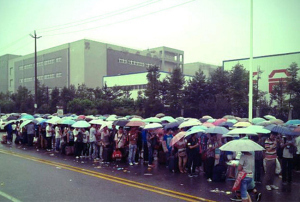
Last Friday, people all over the world joined in and queued up to buy Apple’s latest iPhone – the iPhone 5- which is actually the sixth iPhone, and is a bit bigger than the iPhone 4 and has a different shaped connector. At the central London Apple store alone, a total of 1,297 people were queuing as the doors opened at 8.01am. This beats the previous record, also set by Apple, with the iPhone 4S in October 2011, when 778 people were queuing as the doors opened. (This was repeated everywhere. As many as 1,000 people were waiting outside the Apple Store at Bluewater in Kent, some having arrived at 2am to create “the biggest queue ever seen there”.) You get the picture. Despite costing hundreds of pounds, many, many people – men, mostly – felt compelled to queue up to buy one, even though it would be financially prudent to wait a few days and get a better deal. It’s not about that, though, is it?
Also on Friday, as luck or a compelling narrative would have it, I also picked up my first smartphone. Typically for me, it is a 3G phone, and one that’s three models out of date even in its own manufacturer’s range, which is not Apple. That’s because I aim to stay at least 2G behind the technological curve. This way, I can avoid paying £30 or thereabouts per month for the privilege of having a phone people will queue up to own. Nobody is queuing up to buy the Samsung Galaxy Ace. They might be prepared to wait for up to 5 minutes in a phoneshop to buy the Samsung Galaxy S III, but not the Ace I, which was unleashed onto the smartphone marketplace in February 2011 and has since been superseded by the Galaxy Ace II in any case. But the original Samsung Galaxy Ace is the one I have gone for, as I got a really good deal on it, and you pay £5 a month more for the Ace II, for the privilege of watching iPlayer, which I seriously do not intend to do on my first smartphone.
I have, as regular readers will know, resisted and resisted buying a smartphone. Chiefly because I really didn’t want to become one of those people who plays with their smartphone, on trains, while walking along, at dinner parties. And yet, because I only took delivery of it on Friday, and only took it out into the world for the first time a couple of days ago, I am now, ironically, spending all my time fiddling with it.
The reason I am fiddling with it is that the instruction booklet for the Samsung Galaxy Ace is about two pages long, and the size of a bus ticket. It pretty much tells you how to turn it on and off, and pop the memory card into a slot. So, like someone’s granddad, I’m having to learn how to operate it by trial and error. Plenty of error. On Monday, I left my first message for someone and literally couldn’t work out how to end the call. I didn’t even know I hadn’t ended it until I dialed another number and wasn’t able to connect, because I was still connected. I basically left a message followed by a couple of minutes of atmos, like someone’s granddad. (Funnily enough, my parents, who are also grandparents, recently acquired an iPad, and they seem pretty cool with it. Better than me, at any rate.)

Here is why I took the telecommunications plunge and put my days of carrying a cheap Samsung 2G phone that doesn’t even have a camera [pictured, above] behind me: I went to Edinburgh for the Television Festival and for those pretty intense three working days, for much of which I was out, on my feet, in venues and green rooms and bars, it became blindingly obvious that I could no longer expect to be taken seriously, on a professional level, if I couldn’t check my emails on the hoof. (I have grown used to the fact that, in order to check my emails, I need to have my laptop open, which restricts me to when I’m on the train, or at a desk, or in a coffee shop.) So I caved. So many of the emails I get back say, “Sent from my iPhone,” or “Sent from my BlackBerry,” it’s clear that other media professionals are checking them while on the move, and I’m afraid the smartphone revolution, which happened about five years ago, has finally overtaken my Luddism.
So, as is my way, I spent weeks poring over every deal going until I was finally satisfied that I’d found the best deal within my budget, and the best phone for my needs. I consulted the Twitterhive, which is what I call the “hive mind” of my collective followers, and fielded some positive noises about the Galaxy Ace, and felt that it might be the entry-level 3G phone for me. Although I had decided to buy online, I ventured into a Three Mobile shop in South West London to see if I could play with a phone. I must admit, I always feel old and in the way in phoneshops. Maybe it’s the way they are always laid out, and the way that the young assistants skulk at the back, if you can find a young assistant at all, but I always feel as if I smell of victimhood when I cross their thresholds. As it happened, a really nice, helpful, seemingly sympathetic young woman in Three came to my aid, and explained, as if to an imbecile, that the phones were arranged around the walls, left to right, in ascending order of price. She pulled up a Galaxy Ace I and a Galaxy Ace II and let me play with them. I found both to be light and easy to use, even for an inexperienced screen-swiper like me. She didn’t try to push me into buying anything more expensive, and didn’t even try to tempt me into the Ace II. I told her that it was my first 3G phone, and she didn’t laugh in my face.
Interestingly, having discovered from the Twitterhive that the Ace II accepts Flash and thus supports iPlayer, for instance, which is one of the big drawbacks of the Ace I, I asked the young assistant to confirm this. She didn’t know about it, but confirmed it by trying to download Flash on the Ace I and being told by the phone that she couldn’t. (I had already decided to go for the Ace I at this point, but was glad to expand her knowledge of the phone.)
I had no intention of buying the phone from her, so felt a little dishonest when I left the shop, but I was signing up with Three, so the company was still getting my custom, even if this young woman would not be getting the commission.
I appreciated her help even more a week later when, having taken delivery of my phone, I went back into the same branch to ask for technical help – I couldn’t for the life of me work out how to export all the contacts on my old SIM to my new phone. This time I was accosted by a young male assistant, who conformed to the stereotype of the phoneshop employee: cocky, confident, fast-talking. He definitely thought I was an idiot when I showed him my two phones, and, without listening to my query properly told me, with great amusement, that I could not transfer contacts from a 2G phone to a 3G. I didn’t believe him, and pressed the issue. I cannot lie, I hate young people when they are like this: all talking, no listening. He eventually – grudgingly, I thought, even though I was a Three customer now – took the SIM cards out of the two handsets and, using a magical device, copied all the contacts from one to the other. In other words: if he’d actually listened to my very clear request, he’d have known that he could do what I wanted to do.
Once the old contacts showed up on the Galaxy’s screen, I was delighted, and called the young man “a genius”, which was meant as a compliment. But I could tell that he already thought he was one, even though that genius does not extend to listening. I was glad to be out of there, and vowed to avoid going into a Three shop again, if possible.
A day later, I went into a Carphone Warehouse to purchase a dedicated case for my new Samsung, as I have previous in terms of smashing screens. I found one and took it to the counter. It cost about £12, so nobody was going to get rich from this purchase, but I didn’t expect to be treated like an irritant for wishing to buy it. This time, a young woman intercepted me at the till. Unlike the young man in Three, she was not hyperactive and full of herself; she conformed to a different stereotype, the kind of young person for whom everything is an effort. She told me that the credit card reader wasn’t working and asked if I had the cash. I did not. She went to another till at the back of the shop and shouted me over. I went over. She scanned the case and rang it up. Then she asked for my surname. I told her, politely, that I didn’t need to give her my surname in order to buy a £12 accessory. She insisted that it’s what the till was telling her. She went out the back and found a superior, who was also a young man. He looked at the till and could not make the till stop asking for my details. So I left the case on the counter and left the shop.
Needless to say, I bought the case on Amazon and denied Carphone Warehouse a sale. It arrived two days later. Phoneshops can be pretty horrible places, or at least, they can be if you are not young, and therefore don’t count. I continue to applaud the young woman in the first Three shop, as my other encounters with phoneshop assistants has been pretty unimpressive.
Anyway, I’m enjoying the phone, if finding the onscreen keypad difficult to use, and I’m still unable to get it to accept the correct details for my Plusnet email account, which I’d persevere with if the onscreen keypad wasn’t such a fiddle, and if everything I’ve already typed in could be saved so I didn’t have to keep typing it in. I think I have crossed some kind of rubicon in my life, whereby I am now old. In many ways, I prefer it here. There is less to prove.
Oh, and as a postscript: apparently Carphone Warehouse are in some kind of financial trouble and have had to lay off hundreds of staff. I feel bad for anybody who loses their job – plus, I guess it would be demotivating to work for a company that’s losing business – but maybe if the company made it easier for customers to buy things in their shops, and trained its staff to treat customers with a bit of respect and patience (there was no apology when I was told that the card reader was not working, for instance, and little eye contact at any stage), it would not be in so much financial trouble? Just a thought.

September 21, 2012
Not strictly
 Wow, it’s all big-brand stuff on this week’s Telly Addict: the return of Strictly Come Dancing to BBC1, although not strictly; episode three of Doctor Who on BBC1; the return of Downton to ITV1; and another peek at The Great British Bake Off on BBC2, wherein there will be blood. You have been warned.
Wow, it’s all big-brand stuff on this week’s Telly Addict: the return of Strictly Come Dancing to BBC1, although not strictly; episode three of Doctor Who on BBC1; the return of Downton to ITV1; and another peek at The Great British Bake Off on BBC2, wherein there will be blood. You have been warned.


September 20, 2012
Health, and safety
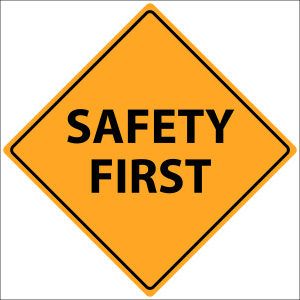
I have been co-writing a script which is now going into production. You know how I roll well enough by now, so I won’t name or describe the project. But I will tell you this: while writing the script, my co-writer and I enthusiastically set one scene in a park lake, and I mean in it. Two characters are in a rowing boat, and one of them has to walk through the shallow water to the shore. This is fine when it’s just words on a MacBook screen, but becomes an “issue” when the words have to be turned into action in front of a camera. We discovered – and we should have guessed – that filming in a lake is a Health & Safety nightmare.
Apparently, even in a shallow pond, once you put an actor into it up to their knees, tests have to be made on the water for specific diseases that may be present, inoculations are required, and a safety boat and a diver must be present. It’s not a problem. We changed the location of the scene. Not really a nightmare at all. But it made me think about the way that the concepts of health and safety have taken on negative connotations since being joined by ampersand in holy non-departmental matrimony. If, for instance, you glance at the Daily Mail, you will see Health & Safety constantly cited as a folk devil for our times; proof that the “nanny state” is out to ruin our lives with its focus on maintaining the rights of employees to work in safety, and without endangering their health. (Richard Littlejohn, the famous wit, likes to write it out as “Elf’n'Safety”, and although I’m not entirely sure why, you get his drift: the very idea is comical to him.)

The Healthy & Safety At Work Act was enshrined as long ago as 1974. It’s not a new concept. It’s not “New Labour”. The Health & Safety Executive, merged with the Health & Safety Commission, is responsible for “the encouragement, regulation and enforcement of workplace health, safety and welfare.” Some might say that its reach extends too far, and into farce, so that the simple act of going about one’s work is often a minefield of regulation and administration. But there is common sense at its heart.
In today’s Guardian, journalist David Conn has written a long and vigilant assessment of the safety failings that contributed to the death of 96 Liverpool fans at Hillsborough on 15 April 1989. It’s worth reading in full although I’ll precis it here. What struck me about this deadly litany of fudging and finger-crossing and hoping for the best is that the evil spectre of Health & Safety was nowhere to be seen, and look what happened. The Hillsborough Independent Panel, chaired by James Jones, the Bishop of Liverpool and charged with combing through all the evidence two years ago by Labour’s Alan Johnson, presented its findings last week, since which all manner of bodies have queued up to issue full, frank and unreserved apologies to the families of the dead, including South Yorkshire Police, the FA, the Sun (not that one more blot on News International’s copybook is going to make much difference this year) and a sniveling Boris Johnson, on behalf of The Spectator. But Conn’s report looks past the appalling mishandling of the situation by the police, and the disgraceful misreporting of the tragedy by the tabloid media, and points the spotlight at Sheffield Wednesday, whose application to host the ill-fated FA Cup semi-final between Liverpool and Forest in 1989 was made despite its ground’s safety certificate not having been updated since 1979.

It was, in modern parlance, a Health & Safety nightmare. According to the report, helpfully and clearly disseminated by the Guardian, “the risks were known and the fatal crush … was foreseeable.” Counsel on behalf of the Hillsborough Family Support Group is calling on the director of public prosecutions to charge Sheffield Wednesday for corporate manslaughter. This is an interesting development, but not one that should come as a surprise. News International have been punished, in Liverpool at least, ever since the egregious Sun headline of April 19, 1989 (“THE TRUTH”). It seems likely that those officers at fault within South Yorkshire Police will at least be investigated by the IPCC. But what of the owners of the stadium itself?
I didn’t know this, but there was a “serious crush” at the Leppings Lane terrace in 1981, at which 38 people were injured. The club’s then-chairman Bert McGee, reacting to the police’s claim that they had averted “a real chance of fatalities” in a post-match meeting, replied, “Bollocks – no-one would have been killed.” This cavalier attitude to health and safety masks a much deeper contempt for the fans. The club erected those metal fences which created “pens”, something the report said made “a demonstrably unsafe terrace dangerous.” A supporter wrote to the FA after another crush at the “old, inadequate” turnstiles in 1988, calling the Leppings Lane terrace “a death trap.” What a chillingly prescient prediction; what a shame it was from a fan. Fans appear not to have mattered much to the FA, or Sheffield Wednesday, in 1988.
The FA asked Wednesday no questions about safety when it awarded them the FA Cup semi in 1989. Lord Justice Taylor, who delivered the first report four months after the disaster, listed all of the club’s “safety deficiencies and breaches of the Home Office Guide to Safety in Sports Grounds (or Green Guide)”, and described Leppings Lane – whose name is now etched on the minds of all who remembers that horrible day – as “unsatisfactory and ill-suited to admit the numbers invited.” The new report merely underlines these findings.
There was a disconnect between the club’s eagerness to host a glamour tie and count the ticket money of the 54,000 people who attended, and the reality of safely siphoning those fans into the stands. 10,100 fans came from Liverpool, and yet the turnstiles at Leppings Lane were “too few to admit so many supporters.” The tunnel into the pens had a gradient of one in six, much steeper than the Green Guide maximum; 40% of the fans were too far from the prescribed distance to an exit; the crush barriers were the wrong height and too far apart; and liaison between the club and the police – as we know – “failed.”
Good heavens, it really is a nightmare, and yet most of this stuff we’re only officially treating as gospel now. (I think most ordinary people knew what went wrong at the time. Certainly Jimmy McGovern’s powerful Hillsborough made it plain in 1996.) But Sheffield Wednesday never admitted liability and not a single director or employee of the club resigned at the time. They didn’t even put up a memorial until 1999. As you know, I’m not a dedicated follower of league football. I come at this story from a pretty casual stratum of devotion to the sport, so if it sounds like I have it in for Wednesday, I clearly don’t; my reaction is based on what I’m reading – and, more viscerally, what I remember so vividly from the heartbreaking news pictures on the day. Trevor Hicks, chairman of the HFSG, speaks of the club’s “contempt” for those fans that died, or their families.
Sheffield Wednesday only made an official apology last Wednesday, on the morning of the report. Dave Richards, who took over from McGee as chairman in March 1990 – apparently prompted to join the board by what he saw on the day at Hillsborough – presided over the dead-air period when the club refused to memorialise the tragedy. He left in 2000, since which he’s been a well-rewarded chairman at the Premier League (his salary last year was £347,000). Under his chairmanship at Sheffield, the ground became all-seated. But the Guardian says that he now admits he didn’t put a memorial up to the 96 who died after legal advice; he was advised that if they put up a plaque it would compromise the club’s denial of liability. This is pretty rum. The families’ lawyer – who happens to be Charlie Falconer, former Blair flatmate and then Lord Chancellor, but wipe those old prejudices aside – says, “The idea that Sheffield Wednesday putting up a memorial would amount to admitting liability is utter rubbish … they wanted to reduce their association with the disaster as much as possible.”
Yes, that Health & Safety disaster.
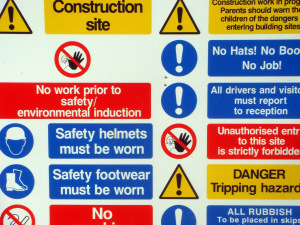
It’s all too easy to fall in line with lazy, Daily Mail orthodoxy and regard Health & Safety with sneering disdain. But if Hillsborough’s safety certificate had been renewed at any time between 1979 and 1989, maybe 96 people wouldn’t be dead (41 of those deaths are currently adjudged to have been avoidable). It might be slightly irritating to have to wear a high-viz tabard, or a safety helmet, or protective gloves, in the workplace, but the same paranoia behind such measures might have reduced the chances of Leppings Lane becoming a “death trap”, into which fans were herded, down an inappropriate gradient, with many different sorts of contempt and neglect.
When representatives of official bodies give a “full and unreserved apology”, as the FA did, you have to check the wording. Are they really apologising fully? Or are they actually apologising partially, in order to avoid admitting liability?
I have been able to rewrite a comedy script to that an actor doesn’t have to be inoculated and stand in a pond, by relocating the scene to a children’s playground. Not so easy to rewrite – or relocate – Hillsborough.


September 18, 2012
New drama on the BBC



As you know, I’m hooked on TV cookery competitions, and I’m currently following The Great British Bake Off – to which I came relatively late – and Celebrity Masterchef – which I have been faithful to since its inception. (Pictured above is my favourite Bake Off contestant, vicar’s wife Sarah-Jane, who I really hope goes all the way to the final, although she’s prone to mistakes and self-flaggellation, and had never been on a train on her own before the competition, so it won’t be a breeze, and that’s why I’m rooting for her.)
You’ve probably noticed, but there’s also a lot of very expensive, star-studded, cinematic new drama on both BBC and ITV – Parade’s End, Downton Abbey, Good Cop, Mrs Biggs … But I sometimes wonder if all of the talented, hardworking, dedicated, creative and technical people who write, perform and produce this drama could ever speed up an audience’s heart rate and lure them closer to the cusp of their sofas as economically and efficiently as last night’s episode of Masterchef, when Emma Kennedy (someone I’ve met!), footballer Danny Mills and Northampton-born TV presenter Michael Underwood were tasked with feeding the hungry cast and crew of … a BBC drama, New Tricks, from a catering truck.
It was all going so well. They were confident. They were on time. And then one of them left a pan of custard literally spinning around on the edge of a work surface …

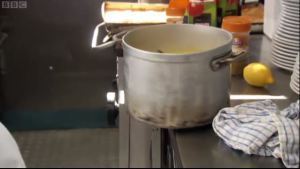
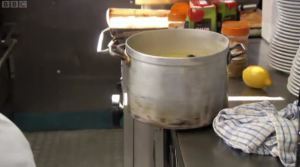
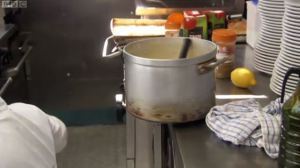
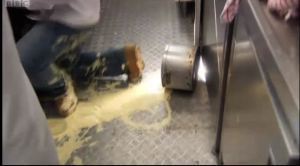



Look at her poor face! (Scroll through on the iPlayer to about 20 minutes in for the moving pictures. Or, watch the whole thing.)


Writer’s blog: Week 40
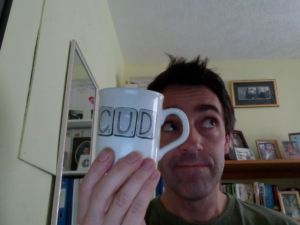
Sunday. I think, actually, today is officially the last day of Week 39, but if I write a bit more tomorrow, it will be Week 40. (Who numbers weeks? Apart from weekly magazines? It’s so impersonal.) I find myself in Northampton for a couple of days, at my Mum and Dad’s, and I type from “the office”, which used to be my bedroom when I last lived here, 28 years ago. Let’s run that number again: 28 years ago. I brought my new Cud mug up with me, the one that Cud kindly sent me, to leave it here as “my mug.”
I came up on the train yesterday. An easy enough journey, just under an hour from Euston if it doesn’t stop at all the incidental stations, like Cheddington and Tring, which it didn’t. (I’m sure they’re not incidental if you live there.) I was sat parallel to a party of six young men who were on their way to Birmingham for a rave-up. They weren’t the most objectionable young men you could share a carriage with, as they weren’t swearing constantly, which is frankly amazing, but they were drinking, and bantering, and doing so at a high enough volume to make it impossible to ignore them without headphones. Because I could hear literally every word they said, I know that they were staying in a hotel in Birmingham, and meeting up with some other mates for a drink, then going on to some exotically named club for 8.45. This was about 2.30. They were a pretty beefy bunch, and I’m sure they could take their booze, but, having broken open a bottle of transparent spirit, and even taken the Glyndbourne-like step of bringing ice to put it paper cups, they were playing cards and drinking shots as forfeits. Even over an hour, you could clearly detect them getting drunker and more slurred, and more “fucks” started creeping into their dialogue.
I feared they were peaking too early, but maybe a nap was built into their itinerary at some stage. When I was a young man, I’m sure I traveled with mates and made similarly gregarious noise (there was one train journey to Derby to see the Boo Radleys in 1993 …), but am I simply post-rationalising if I suggest that my generation had a bit more self-consciousness than the current younger one?
It’s always pleasant, and a bit weird, to be back in Northampton, especially as my folks still live in the house we moved to in 1983, a year before I left (and to which I returned regularly during the next three years at Chelsea). In many ways, it hasn’t changed a bit. My sister and her family still live here – a five minute drive away – and very few of the next tier of the family have strayed very far. My Dad’s sister and her husband spend a lot of time in their apartment in Spain, and one of my male cousin’s two daughters has literally just ventured down to London to go to university, which has been big news within the clan. Good for her, I say. It’s not contractual to leave the town you grew up in – and if you’ve read my books, you’ll know that I owe Northampton a lot, and regard it with massive affection – but it’s good to test your boundaries, and see if perhaps they were further out than you imagined.

Because it is Monday, I find myself at Mum and Dad’s on the very day that they go out for an organised ramble, with friends. This is a regular meet, once a month, and it involves a gentle walk though the open pastures of Northamptonshire, beginning in the car park of a pub that serves good food, and ending in the car park of the pub that serves good food. I have heard tales of these walks, and they always sound bucolic and encouragingly local and not too strenuous, and with a pint and a plate of grub built tantalisingly in. So I accepted the invitation to join them, and make the number up from 11 to a round 12.
We gathered at 10.30am in the car park of the Britannia on the old Bedford Road. Now, I know this pub of old as a remote outpost of hospitality visible from the A428 and nestled by the river Nene. Today, this once-rural inn is blocked in on all sides by newly-built office blocks and retail-park hotels (which must be good for business). The pub itself, inevitably run by a national chain owned by an even bigger national chain, seemed really welcoming, especially after a three-mile hike, but had this lunchtime been cursed by a power failure. So we drove to the next likely spot, the Lakeside, another pub run by a national chain, but also, sadly, jinxed by the same local power outage. We ended up – happily – at a less corporate, more cosy, lower-ceilinged pub in the village of Great Houghton called the Old Cherry Tree, whose friendly staff rose to the challenge of seating and feeding a dozen middle-aged ramblers with a thirst.

Mum and Dad’s friends, a bunch of retirees of similar vintage – and most of whom I’ve met at Wellingborough & Hatton Rotary functions where my Dad had to provide the speaker, so it was me – proved voluble and inclusive company, and I enjoyed being the token under-50 among their sensibly-shod ranks. They joked about me turning them into a sitcom, and the funny thing is, it might just work (mental note etc.). There’s something charming about the over-60s, as we shall politely call them, and the comfortable way they mock each other and chuck innuendo around and claim to be eating “healthily” by not ordering the chips, but then eating chips off other people’s plates. I wouldn’t mind being like them when I am over-60, and I salute them for building this exercise/booze-up into their monthly calendar. (Part of our walk, by the Nene, seemed to coincide with the famous Nene Way. It certainly took us up to Weston Mill, which is a spot I visited as a child, and which terrified me then.)
Living in London, the countryside feels far away. In Northampton, you don’t have to go far out to hit rolling fields. The town is speckled all around its edges with gorgeous villages, like Great Houghton, and a pub lunch can never be far away. They do not call them “gastropubs” round here, as they are unpretentious, but they hit the spot.
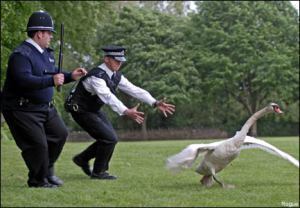
As did Hot Fuzz, which I watched again last night, having “taped” it off ITV2 the night before. (My used of “taped” on Twitter caused a degree of nostalgic merriment.) Having already been awestruck by Shaun Of The Dead, and its Pegg/Frost/Wright progenitor Spaced, I knew Hot Fuzz was going to be for me, but remember being even more blown away by its fizzing, metatextual ambition than I’d hoped when I saw it in 2007, prior to meeting Pegg for the first time for a Word magazine interview, after which we rather sweetly stayed in touch. Although the shock value has gone, I was still blown away, again, by how rich and funny it is. Bring on The World’s End, the pub-crawl finale to their Three Flavours Cornetto trilogy and being filmed, well, right now.
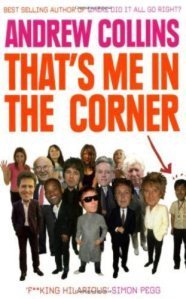
It is Tuesday. Here’s a weird thing. Yesterday, I picked up a copy of the finale to my own trilogy of memoirs, That’s Me In The Corner, published the same year Hot Fuzz came out. (And for the cover of which Simon Pegg kindly supplied a quote. What a shame even his mighty reputation couldn’t help us shift a few copies!) The reason I did so is that in October, it joins Where Did It All Go Right? as an e-book. I’m excited about this, so I idly flicked through it, wondering if it really was as bad as its sales figures and near-total lack of press coverage suggest.
Do you know what? It’s quite interesting. I mean that objectively. With its tales of pre-PC newspaper publishing, pre-Internet journalism, pre-digital radio, pre-satellite TV and pre-Twitter information sharing, it may just have evolved into a valuable social document. It’s only six years old, but it seems so very quaint.
Also, if Twitter had ruled the world, I would have been able to promote it myself, without the help of a disinterested publisher. I looked it up on Amazon, to confirm its e-publication (you can pre-order it for £7.69), and, of course, found myself doing the thing you should never do …
I must admit, because it was roundly ignored by the press on publication, I was delighted at the time to get a couple of rave customer reviews on Amazon. I have rarely checked back since. These raves have now being tempered by some real stinkers! Now, before you say it, I know you need thick skin to put yourself out into the public domain, but I always found negative customer reviews the most astringent (and we are talking one-star assassinations in some cases), as these poor bastards will have paid good money for my work. If a critic doesn’t like it, so what? I have not fleeced them of any money, only time. As an author, you do not wish to pickpocket anyone, and fervently hope that a combination of honest packaging, hard work and the context of your previous endeavours will be enough to frame an informed purchase, and thus rule out crashing disappointment. But this isn’t always the way.
“Disappointing … a chore … dull” … These were not the reactions I was aiming for when I wrote That’s Me In The Corner, as you can imagine! Anyway, as my publisher said to me on publication of my first book, in 2003, when I earned my first Amazon customer slag-off, this puts me in the same bracket as Ian McEwan and Martin Amis. I’m feeling more philosophical about the negative reaction to the book now – and the most negative reaction of all was not to even mention the book, a route most national publications took! – and wonder if, by the power of Twitter and the passage of time, That’s Me In The Corner will take on a new, Kindle-fanned life? If it sells two downloads, I shall be happy, as long as the two people who download it are happy. (I wonder if Ebury will let me write a new chapter dealing with that last six years? Hmmm.)
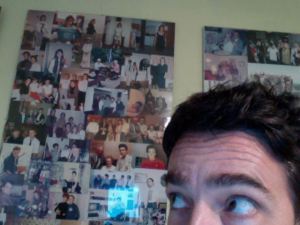 This is me posing in front of three large photo-collages my parents made a few years ago and which are clip-framed up in the “office”. (Actually, maybe my brother made them?) Not that you’ll be able to make much out from where you’re sitting, but the middle one is themed around me, my brother and my sister, from childhood to young adulthood. (The one to the left, out of shot, is based around their kids; the one to the right, partially obscured, is all Mum and Dad.) They’re fun to gaze at, with all their fashions and their haircuts. A couple of days at your parents’, and you do tend to fall into nostalgic reverie.
This is me posing in front of three large photo-collages my parents made a few years ago and which are clip-framed up in the “office”. (Actually, maybe my brother made them?) Not that you’ll be able to make much out from where you’re sitting, but the middle one is themed around me, my brother and my sister, from childhood to young adulthood. (The one to the left, out of shot, is based around their kids; the one to the right, partially obscured, is all Mum and Dad.) They’re fun to gaze at, with all their fashions and their haircuts. A couple of days at your parents’, and you do tend to fall into nostalgic reverie.
My new 3G phone, the Samsung Galaxy Ace I, is supposed to arrive today. I am entering the future – or the recent past, as the Ace I is very much last year’s model – while at the same time gazing at my distant past. My parents have recently bought a new PC for the “office”, and with it, changed broadband provider from Orange to BT. They wish to move certain important emails from their Orange account to BT, but due to computer woes, had been reliant for way too long on the remote Orange website client, where their emails are now stored. I set Outlook Express up for them and hooked it up to BT, so that they may now use that to retrieve and send emails, but I could not for the life of me get Outlook to import message from the Orange website. I actually spent a lot of yesterday afternoon trying, and failing. I asked the glorious hive mind of Twitter – the Twitterhive – and received a lot of helpful advice and hints, but none worked, and it looks as if my Dad is going to have to simply forward the important messages to the new account by hand – a laborious task, and one we were trying to sidestep.
If you have any further advice (and I even tried setting up a Gmail account and importing to that, but the password kept being rejected, even though it’s correct, so I gave up), there’s still time!
In the meantime, I have work to do, so will end this Northampton-based blog entry with another pic that sums these past couple of days up. (Thanks for having me, Mum and Dad!)
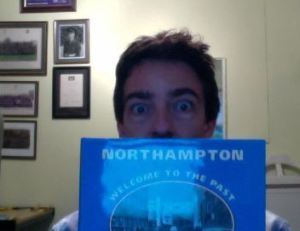


September 17, 2012
The badger cull: a personal viewpoint
September 16, 2012
It’s a royal knockers-out

Pardon the deliberately lowered tone of the headline, but we must dip a toe here into the murky depths of tabloid intrusion and a very British obsession with bared flesh. Kate Middleton, an attractive if thin Berkshire woman of 30 whose official title is Her Royal Highness The Duchess of Cambridge – or has been since she married, with her eyes wide open, Prince William, His Royal Highness The Duke of Cambridge, Earl of Strathearn and Baron Carrickfergus, in April 2011 – is currently on holiday. It is a working holiday, in the sense that she didn’t choose it, or plan it, and while on it, much of her time is being spent doing things she wouldn’t normally choose to do, while being photographed doing it. This is the life she chose.
Although her role in life is now predominantly played out in public, by her own choice, and much of what she does during the day is arranged specifically to be seen by the public, she is, like anybody entitled to private time. Of course she is. What she does in private is nobody’s business, unless it is against the law, at which point her qualification to represent this blighted nation before the rest of the world would be called into question. To my knowledge, she has not broken the law, and seems, if anything, quite nice.

However, last week, during some private time before embarking upon her current, paid, working holiday of Southeast Asia, she relaxed at the private chateau of Viscount Linley – which is his whole title – son of Princess Margaret, Countess of Snowdon, and Antony Armstrong-Jones, 1st Earl of Snowdon. (Linley’s daughter was a bridesmaid at the wedding of the Duke and Duchess of Cambridge in April 2011.)
The royal couple called it a “second honeymoon”, according to the press, who must have been fed this information. And why not? The Chateau D’Autet in Provence, is set “amid 640 acres of lavender fields and woodland”. The temperature while they were there reached 31C (88F). Perfect weather for sunbathing, like normal people do.
During a spot of sunbathing, among friends and family, it seems that Kate took off her bikini top. We know this because a man photographed her in this state of undress with a long lens. As far as I know, he is not the first photographer to use a long lens. Again, as far as I can tell (as I haven’t seen the photos, other than on photos of the cover of Closer on the newsstands, which are on the internet), Kate went topless outside, on the verandah or balcony of Linley’s chateau. Now, outside on private property may be private on paper, but if you are outside, in the world, that privacy is harder to apply in actuality. The result of this confusion: scandal. And the second example of illicitly-documented young, royal nudity in two months.
In August, Prince Harry – sorry, His Royal Highness Prince Harry of Wales – took his clothes off in a hotel room in Las Vegas, during a game of what was reported as “strip billiards” and, seemingly, unsupervised. (One imagines the young royals are usually chaperoned for most of the time.) Photos of this nakedness were published in this country in the Sun, and the paper seemed to get away with it. He was naked in private, behind closed doors, but, unfortunately, among a bunch of other people who did not necessarily respect that privacy. Frankly, you take your kit off in a hotel room with other people in it, especially when phones are cameras, and you run the risk of photos being published. This, presumably, is why Clarence House didn’t attempt to sue anybody after the fact.
With Kate, it’s different, apparently. The French version of Closer magazine splashed the pictures (“Oh My God,” it squealed, in the international language of exclamation) and the magazine is being sued. The Irish edition of the Daily Star has also reprinted them, with an Italian magazine, Chi, threatening to do the same now. (Richard Desmond, the notoriously prurient and censorious owner of Northern & Shell, which publishes the Express and the Star, and co-publishes the Irish Star, has threatened to take his ball home and withdraw his stake after the publication of the snaps.)

So … before I comment on the whole hoo-hah, may I just state the following facts:
I am a republican. I do not believe in the royal family. Which is not to say I do not believe that the current royals are descended from previous royals, or that there is such a thing as royalty, or that the current House Of Windsor goes back to 1917, before which it was called the House of Saxe-Coburg and Gotha. I know that the crowned heads of Europe are all historically sort of interrelated, and that cousins have always been marrying, and that by this complicated series of fluid exchanges does Kate Middleton now get called Her Royal Highness as if perhaps we still live in the 15th century. I also know the powers of the constitutional monarchy are limited. I still firmly believe that by the state funding these decorative ambassadors, who are some of the richest landowners in the country, is wrong. I do not think the royals should be guillotined, merely stripped of their public funding and asked to fend for themselves, like the other aristocrats with all their assets.
The world we live in is a coarse and ugly one, and no matter what the outcomes of the Leveson Inquiry, and the News International criminal prosecutions, it is unlikely that our newspapers will suddenly stop being interested in famous people at any time in the foreseeable future. The celebrity culture is here to stay for as long as it sells papers and advertising. I find it unedifying. But for as long as we all flock to the newsstands and the websites to seek out grubby gossip about people who are only by the smallest margin more famous or richer than ourselves, the papers and the websites will continue to print it, within the bounds of the law.
Exhibitionism is now standard. Where once this country was renowned, and mocked, for being stuffy and sexless and tongue-tied and shy, we now seem to flaunt ourselves and our emotions with abandon. We make more noise. Sometimes this noise is cheering, as heard at the Olympics, and can be good noise. Sometimes it is simply shouting, as heard on trains and buses and in the streets after 11pm in cities, or in the afternoon if the sun’s out. (I passed through Euston station yesterday and a man, with his top off, was slumped at the feet of his friends at an outside table on the piazza, shouting at the world.) I am not John Major, or Mary Whitehouse; I do not wish a return to Victorian values, but my abiding prudishness does seem to make me feel increasingly out of step with modern thinking. This is my problem.

With all this said – and I hope I have painted a depressing enough picture for you! – I will say this: Kate Middleton is an idiot. Why, when she is the wife of the future King of the United Kingdom and the 16 sovereign states of the Commonwealth (gosh, even typing those words makes me feel a bit queasy), would she take her bikini top off when she is outside? It was the daytime. The clue that she was no longer inside, away from prying lenses, was that there was a sky above her. Prying lenses work best when there are no bricks between them and the subject. Paparazzi scum have been plying their trade since the 1960s when the term for their profession was coined in Fellini’s La Dolce Vita (in which news photographers harass a visiting film actress, and, in a neat reversal, one of their scrum travels out to photograph a sighting of the Madonna at a church). Fellini said that the word Paparazzo “suggests to me a buzzing insect, hovering, darting, stinging.”
Kate’s husband, William, is the bereaved son of Her Royal Highness The Princess of Wales, herself hounded by the paparazzi, who were certainly on her tail when her car crashed in a Parisian tunnel, killing her, in August 1997. If ever a new royal knew what she was getting into, it was Kate Middleton. I am not Kate Middleton. But if I were, the one thing I would make sure I never did, ever, was to take my top off outside. Just in case. (We might remember that no topless shots of her late mother-in-law and arch publicity-manipulator Diana ever came to light, so we have to assume that she never went topless outside.)
It is a tragedy that a 30-year-old married woman cannot take her top off on the balcony of her bridesmaid’s parents’ chateau in Provence without being photographed from a very long distance away by a man who makes his living selling his photographs to magazine and news agencies, but there it is. I feel sorry for her up to a point, as her freedoms, as a holidaymaker in the South of France, have been curtailed in a way that an ordinary woman on a balcony’s freedoms would not be. But then, she is a member of the royal family, and I stopped feeling 100% sorry for her the day she agreed to join this unlikely and surreal firm of interrelated people.
Closer’s editor-in-chief Laurence Pieau described the photos as “beautiful” and claimed that they’d not printed anything degrading: “There’s been an over-reaction to these photos. What we see is a young couple, who just got married, who are very much in love, who are splendid. She’s a real 21st Century princess … a young woman who is topless, the same as you can see on any beach in France or around the world.”
Hey, I’m quaint enough to still be against Page 3. I don’t think women’s breasts should be shown in newspapers which can be seen by children and impressionable teenagers. This is the kind of 1980s woolly liberal I am, and if grown women want to be topless on beaches around children and people they don’t know, that must be their right. And with the internet, you might argue that what’s on the third page of a newspaper doesn’t matter any more. (I think it does.) We all agree that Kate Middleton has not committed a crime. When I first heard that topless pictures of her had been printed, I assumed these were from the days before she was married, from some scummy ex-boyfriend or something. If they had been, I would have had full sympathy for her, as she can’t really have known she was always going to be a “21st Century princess”.
But she slipped up. The world outside the walls of her chateau – a safehouse – is a sleazy one. She should know better. Don’t feed the trolls. The trolls have cameras.


September 14, 2012
Dinosaurs. Spaceship. Pies.
 What more do you need from a week of TV? This week’s Telly Addict remains devoted to The Great British Bake Off on BBC2 and to Doctor Who on BBC1; with nods at newness with Mrs Biggs on ITV1, the continuing Hunderby on Sky Atlantic (for whom, to declare an interest, I am currently developing something via a third party – say no more); and a new series of an old favourite, The Thick Of It, on BBC2. Contains strong language from the middle, but not as much as you might have expected from The Thick Of It, even post-Malcolm.
What more do you need from a week of TV? This week’s Telly Addict remains devoted to The Great British Bake Off on BBC2 and to Doctor Who on BBC1; with nods at newness with Mrs Biggs on ITV1, the continuing Hunderby on Sky Atlantic (for whom, to declare an interest, I am currently developing something via a third party – say no more); and a new series of an old favourite, The Thick Of It, on BBC2. Contains strong language from the middle, but not as much as you might have expected from The Thick Of It, even post-Malcolm.

September 10, 2012
Theatrical release

It was Baz Luhrmann who coined the phrase “red curtain cinema” to cover his loose trilogy Strictly Ballroom, Romeo + Juliet and Moulin Rouge. What he meant by it was film that embraced the theatre and revelled in the theatricality of performance, even when frozen in celluloid and thus robbed of that particular verité. Song, dance, heightened reality, a certain opulence, a sense of camp, grandeur and all-round stagey staging add to the effect, and as someone who saw Moulin Rouge in a huge, impersonal West End cinema in the immediate, overcast aftermath of 9/11 and found myself part of an ordinary paying audience cheering at the end, I can account for the best of the effect “red curtain” achieves.
Joe Wright’s Anna Karenina is part of that tradition. It wasn’t always meant to be this way – indeed, Wright’s last-minute decision to re-stage and shoot Tolstoy’s torrid aristo-romance in a theatre and to make that its narrative and visual advantage apparently drained the colour from screenwriter Tom Stoppard’s cheeks, and has rubbed some critics up the wrong way, too. Me? I found it not only bold and brave, but mostly thrilling. A gamble that paid off.
Historically, the novel was staged before it was filmed, in 1907, but its most famous adaptations have been for the screen – Greta Garbo in the 1935 version; the 1977 BBC series with Nicola Pagett; perhaps even the 1997 one with Sophie Marceau, the first Hollywood adaptation to be filmed in actual Russia. This, however, is something different. It begins in the theatre, with Matthew McFadyen playing Count Oblonsky in heightened farce mode, and the actors moving betweens sets and backdrops, with stage hands lurking and scenery being changed. The “realism” of the theatrical setting is challenged at key moments; firstly, when Levin (a suitably dour and serious Domhnall Gleeson) leaves St Petersburg for the countryside and steps outside of the theatre into a vast, David Lean-style snowy landscape. (I haven’t read or studied the book, but I can see that the contrast between the ritualised dance of town and the agrarian honesty of the country is key.)
For me, when the action deliberately and symbolically moves outside of the constrictions of the theatre to convey the vastness and openness of the country – where, for instance, Levin mucks in with the workers on his estate in what looked like a deliberate, dappled echo of Days Of Heaven – some of the film’s singular magic ebbs away and the film becomes conventional again. (That said, the way the scythes swoosh in time to Dario Marianelli’s soundtrack pulls it back a bit.) Conversely, when Keira Knightley, as Anna, sits beneath a toy railway to reassure her young son before heading off to Moscow, and then we zoom in on the lit carriages of the toy train in a fake snowscape, wherein Anna now travels, it is a captivating leap from artifice to “reality”.
Some have found Wright’s approach a bit “arm’s length”, and criticised him for removing us from the emotion of the story by placing obstacles in our way, but while I accept that much of the cleverness – including a horse race with actual horses also held inside the dilapidated auditorium, and a government office building transformed into a restaurant, with workers revealing aprons beneath their formal suits to become waiters – is designed to dazzle rather than involve, this is an artistic risk, and you have to credit Wright for taking it.
And anyway, the performances are rich and real enough, notably Knightley’s and that of Jude Law as her cuckolded husband. Both these performers improve with age, and while Law might have been playing the cocky Count Vronsky if the film had been made ten years ago, I prefer him as the balding, formal, upstanding Count Karenin. Aaron Taylor-Johnson is Vronksy, and embodies all the arrogance of privileged youth. He’s not likable, but is he supposed to be? Too many decent actresses are reduced to cameos – Shirley Henderson, Holliday Grainger, Emily Watson, Michelle Dockery, even Ruth Wilson’s part is relatively small – but then this is one of those lavish costumed productions that actors presumably fall over themselves to be in, and in the patriarchal society it depicts, the men are in charge while the ladies fan themselves in royal boxes. Of the female characters, only Anna is allowed any real substance.
At its most Luhrmann-esque, a courtly dance, choreographed by Sidi Larbi Cherkaoui, seems to blend a more modern framework over the 19th century formality, with an intricate interweaving of hands and arms that almost threatens to usher in a modern dance track, as per Moulin Rouge (amid whose wayward wackiness, it might have worked). Thankfully, this never happens, and Wright keeps a tighter lid on the inner logic of his production. I almost yelped when Vronksy and Karenin – by now locked in a Cold War for Anna’s affections – leave and enter by adjoining revolving doors in the lobby of the theatre, glimpsing each other through the glass; this is Wright hitting the jackpot.
It’s a long book, and the film is too, at 130 minutes, towards the end of which I found myself drifting a little. But overall, despite the aforementioned remoteness, I thought this Anna was a treat. Oh, those Russians.

Andrew Collins's Blog
- Andrew Collins's profile
- 8 followers






